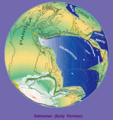Permian facts for kids
| Permian Period 298.9–251.902 million years ago |
|
| Mean atmospheric O2 content over period duration | c. 23 vol % (115 % of modern level) |
| Mean atmospheric CO2 content over period duration | c. 900 ppm (3 times pre-industrial level) |
| Mean surface temperature over period duration | c. 16 °C (2 °C above modern level) |
| Sea level (above present day) | Relatively constant at 60 m (200 ft) in early Permian; plummeting during the middle Permian to a constant −20 m (−66 ft) in the late Permian. |
|
Key events in the Permian
-300 —
–
-295 —
–
-290 —
–
-285 —
–
-280 —
–
-275 —
–
-270 —
–
-265 —
–
-260 —
–
-255 —
–
-250 —
An approximate timescale of key Permian events.
Axis scale: millions of years ago. |
|
The Permian is a geological period which started about 299 million years ago (mya), and ended about 252 mya. It is the last period of the Paleozoic era, and ended in the largest mass extinction known to science.
Data
- Oxygen content of atmosphere: 23% (115% of modern level).
- Average CO2 content: 900 ppm (3 times pre-industrial level)
- Average surface temperature: ~16oC (2oC above modern level)
- Sea level: 60 metres above present day level; plummeting during the middle Permian to a constant minus 20 m in the late Permian.
Climate
The climate in the Permian was quite varied. At the start of the Permian, the Earth was still at the grip of an Ice age from the Carboniferous. Glaciers receded around the mid-Permian period as the climate gradually warmed, drying the continent's interiors. In the late Permian period, the drying continued although the temperature cycled between warm and cool cycles.
Life
During the Permian tetrapod life, (amphibians, Sauropsids and Synapsids) which evolved in the Carboniferous, became widespread and diverse. The first modern trees (conifers, ginkgos and cycads) appeared in the Permian.
Insects
The Permian was also a period of adaptive radiation in insects. Beetles (Coleoptera) appeared; so did flies (Diptera). 22 out of a total of 36 known orders of insects are known from the Permian. Some became extinct in the end-Permian event, but more radiation followed in the Mesozoic. Insects were probably, by the end of the Permian, the largest phylum, in terms of number of species.
Early relatives of cockroaches (Blattopterans) were the most common insects. and dragonflies ruled the air. True Odonata appeared in the Permian.
Pangaea
All the major land masses were collected together in the super-continent Pangaea. At the end of the period, the greatest flood basalt lava flows in the Phanerozoic raised world temperatures, and damaged the environment. These formed the extensive Siberian traps. The causes of the Permian/Triassic extinction event are not yet agreed between scientists. Trilobites, once a dominant life-form in the ocean, became extinct, together with 90% of all marine species.
Images for kids
-
Selwyn Rock, South Australia, an exhumed glacial pavement of Permian age
-
Hercosestria cribrosa, a reef-forming productid brachiopod (Middle Permian, Glass Mountains, Texas)
-
Edaphosaurus pogonias and Platyhystrix – Early Permian, North America and Europe
-
Dimetrodon grandis and Eryops – Early Permian, North America
See also
 In Spanish: Pérmico para niños
In Spanish: Pérmico para niños











